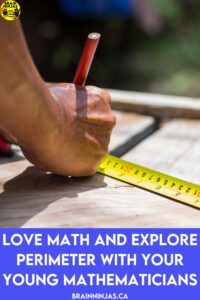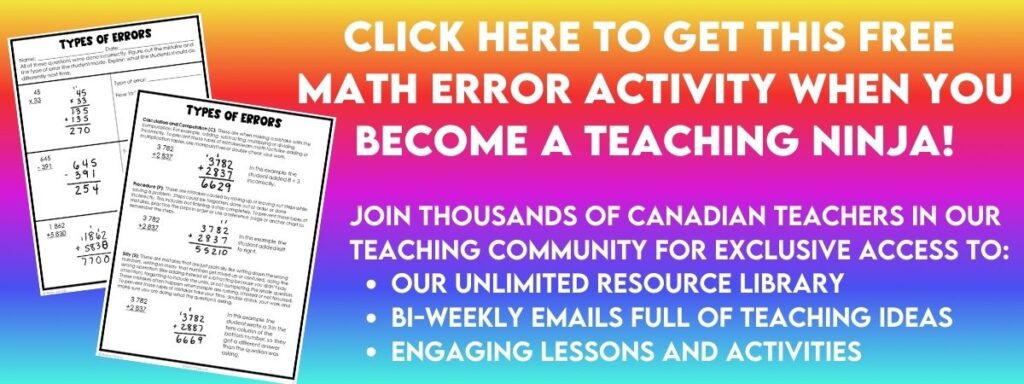
When people ask, “When will I ever use this?” perimeter is often an example of a real-world skill that people need. Understanding how to measure it is important for construction, landscaping, sewing, and painting.
Students usually start off understanding perimeter when we measure with non-standard units. But, as soon as we start adding formulas or other measurements, like area, students begin to struggle. Check out the ways we help build a strong foundation for measuring perimeter with our upper elementary students.
Avoid all the Terminology

Before getting into the math, give students a simple activity they can do with non-standard units. For example, have them measure the walls of the classroom using skipping ropes or measure the edge of the table with a math book.
You don’t need to explain anything other than measuring the outside edge of an object and counting the number of times you can lay the object end to end.
Once students can do this, talk about why using standard measurement units (like the metric system) is important. Have students repeat the task, but give them rulers, metre sticks, or measuring tapes. Choose a unit of measurement and ask students to measure the same places they’ve measured.
Once done, ask students to think about when they would need measurements for the outside of an area. Use real-world examples, such as building a fence or tracing a border.
Once students understand this measurement, then you can call it perimeter. Explain to students that perimeter is the distance around the boundary of a two-dimensional shape, such as a rectangle, square, or triangle.
Include the measurement after the number.
Practice Measuring With Manipulatives
Before moving to measuring shapes with formulas, try using manipulatives first.
Geoboards
Geoboards are plastic boards with pegs on which elastic bands can be stretched to make shapes. Have students create a shape with an elastic band. Then, they will count the number of pegs around the edges of the shape. The measurement would be the number of pegs.
We have a set of worksheets you can use with geoboards (or in place of the physical boards if you don’t have any available). Find the Perimeter With Geoboards Worksheets in our TpT Store ($USD) or our BN Shop ($CAN).
Pattern Blocks
Use geometric shapes such as pattern blocks or tangrams to create composite shapes. Have students arrange the shapes to form larger figures. Trace the outside of the shape using a piece of string. Measure the length of the string.
Blocks
Provide students with building blocks or interlocking cubes to construct shapes. We use the ones from our Base 10 set. Challenge students to create shapes. Count the number of blocks used along the boundary.

Grids or Graph Paper
Have students draw shapes on graph paper. Count the number of squares along the sides of the shape.
We have a set of worksheets that you can use to practice measuring perimeter with grids. Find the Perimeter With Grids Worksheets in our TpT Store ($USD) or our BN Shop ($CAN).
Create Puzzles
Create perimeter puzzles where students are given incomplete shapes and must determine the missing side lengths to calculate the perimeter. Provide grids or rulers to help students visualize and measure the sides.
Give students all the side measurements except one, along with the perimeter measurement. Students will try to figure out the length of the missing side.
Another way to create a puzzle is to complete a worksheet incorrectly and have students find the errors. While the activity shows errors for operations, you can use it for perimeter, too. We created a simple lesson to help students identify errors. We’ll send it to you for free when you sign up for our email list. If you’re already on the list, you can find it in the Resource Library.
Create Art
Engage students in an art project where they create abstract designs or patterns using string and pushpins on a bulletin board. Have students measure the perimeter of their designs and compare them with their classmates’ creations.
Go Outside
Take students on an outdoor perimeter hunt where they explore the school grounds or a nearby park to find objects. Have students measure and record the measurements of each object using measuring tapes or rulers.
Calculate With Formulas
Once students have the basics, they are ready to move on to making calculations. If students aren’t quite ready for a formula, start by adding up the sides.
Introduce students to perimeter formulas for common shapes such as rectangles, squares, and triangles. Guide students in understanding how to apply these formulas to calculate perimeter efficiently.
Worksheets or Task Cards

We have different resources that may be helpful to practice with your students.
Our task cards come with three decks so you can easily differentiate based on the needs of your students. We include a paper version with suggestions for how to get your students up and moving. There’s also a Google Slides version to help cut down on paper or a Google Forms version that you can use (and it marks the answers for you). Find the Perimeter Task Cards in our TpT Store ($USD) or our BN Shop ($CAN).
Worksheets include fifteen different pages that work at slightly different levels. These are only available in paper and include answer keys.
Find the Perimeter of Rectangles (students can use formulas but are not required to) in our TpT Store ($USD) or our BN Shop ($CAN).
Find Perimeter of Complex Shapes in our TpT Store ($USD) or our BN Shop ($CAN).
If Your Students Need More Support

Lesson Plans
Our interactive math units include complete lesson plans with background information for teachers. We have added worksheets that can be used for practice, review, or formative assessment. There are games and activities and even a formal assessment for measurement outcomes. Everything you need is included, and we’ve aligned these resources for Alberta, British Columbia, and Saskatchewan, but they will still work for the majority of Canadian classrooms.
We have only included grade levels where perimeter outcomes are part of the curriculum.
- Time and Measurement for Grade 3 on TpT ($USD) or BN Shop ($CAN).
- Measurement for Grade 4 on TpT ($USD) or BN Shop ($CAN). This includes measurement activities for rectangles, regular and irregular polygons and complex shapes using any strategy.
- Measurement for Grade 4/5 on TpT ($USD) or BN Shop ($CAN). This includes measurement activities for rectangles, regular and irregular polygons and complex shapes using any strategy.
- Measurement for Grade 5 on TpT ($USD) or BN Shop ($CAN). This includes measurement activities for rectangles, regular and irregular polygons and complex shapes using any strategy or formulas.
- Measurement for Grade 5/6 on TpT ($USD) or BN Shop ($CAN). This includes measurement activities for rectangles, regular and irregular polygons and complex shapes with formulas.
- Measurement for Grade 6 on TpT ($USD) or BN Shop ($CAN). This includes measurement activities for rectangles, regular and irregular polygons and complex shapes with formulas or any strategy that students can explain.
Videos
Math Antics offers instructional videos that explain the concept of perimeter and demonstrate how to calculate perimeter for different shapes using metric units.
Khan Academy has tutorials on calculating perimeter for various shapes, with step-by-step explanations and practice problems.
Do You Teach Math in Canada?
Whether it is metric units or SI notation, teaching math in Canada is uniquely Canadian. These blog posts might be able to help you out.
- Ways to Teach Classifying Triangles
- Amazing Measurement Activities to Stretch Math
- How to Teach Students to Analyze Errors in Math
Do you have another way that you help students understand perimeter? Tell us all about it in the comments below.







